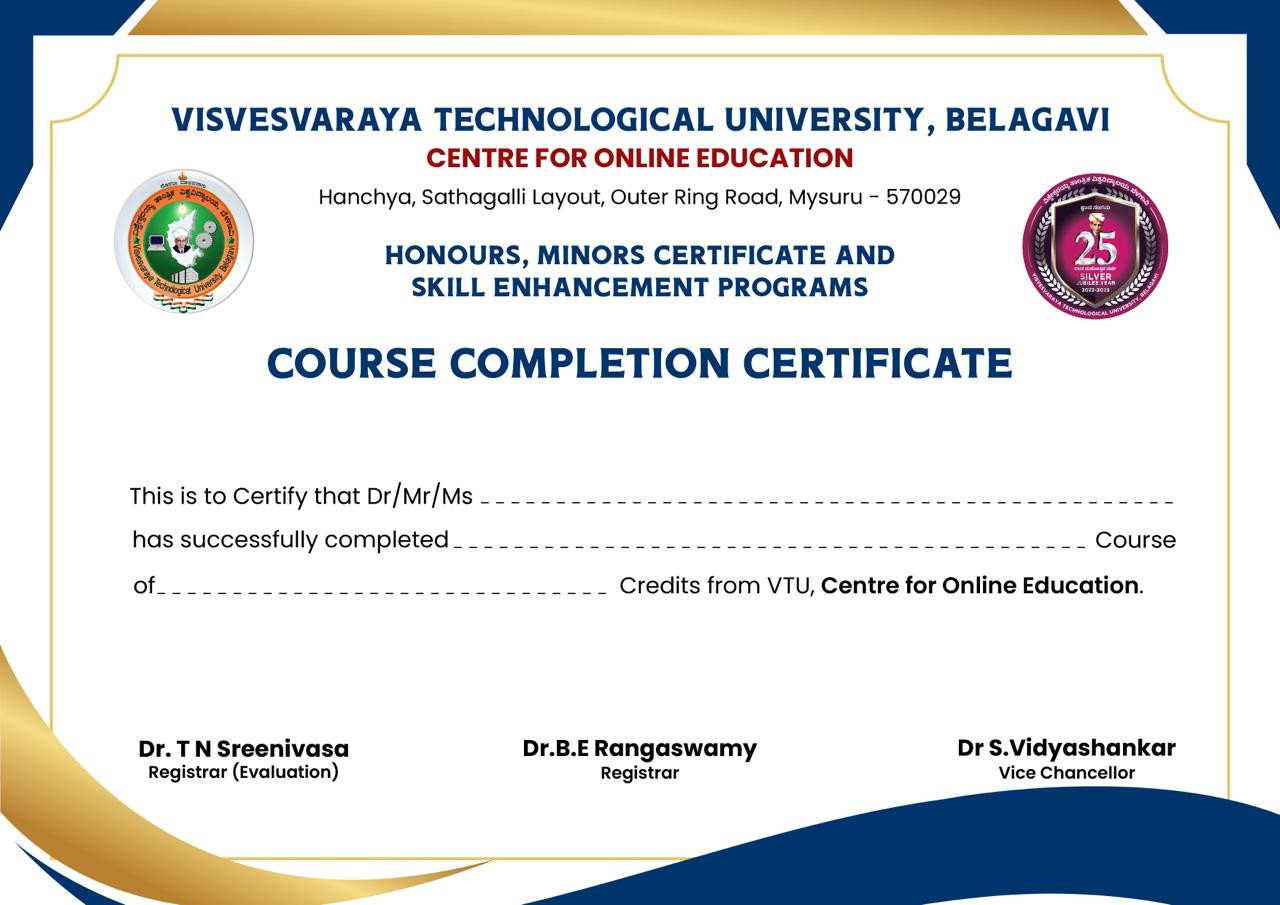Why chose our Internet of Things (IoT) ?
1. Learn IoT fundamentals, Sensors and devices, Short haul and long haul communication, Sensor interfacing with databases and MQTT, Security services, Anatomy of attacks, Cryptographic tools, IoT application development on cloud, Data management and analytics, Cloiud platforms
2. Virtual hands-on environment integrated within the course to help learners to try what they have learned practically, Project based industry assignments designed by industry experts to implement learning
3. Three Periodic Formative Assessments to assess course progress
4. Remote internship opportunity and Placement assistance for successful candidates
5. Dedicated online course communities to connect with academic and industry experts
6. Helpdesk support for quick resolution of queries
Accelerate your Career with an Honour Degree
Online | 18 Credits | Expert Lectures
Criteria
1. B.E/B.Tech. Students in their 5th semester onwards who want to diversify their careers in the indus
2. Lectures from renowned Subject Matter Experts from leading Academia Industry, Access to self paced
3. Built in hands on environment for practical implemention of the technologies covered, Industry assi
4. Enhance your career with Remote Internship Opportunity and Placement Assistance.
What will you learn from the program?
1. Total Credits earned: 18 credits (across 3 courses and 270 hours of learning)
3. Key learnings: IoT fundamentals, Sensors and devices, Short haul and long haul communication, Sensor interfacing with databases and MQTT, Security services, Anatomy of attacks, Cryptograp
5. Remote internships
2. Learn IoT and its Applications using Raspberry Pi, Information Security – A practitioner’s perspective, IoT Application Development on Cloud
4. Project based industry assignments
6. Visibility to placement opportunities for successful candidates, subject to hiring criteria of corporates.
Curriculum
1. IoT and its Applications using Raspberry Pi:
IoT and its Applications using Raspberry Pi is a course that provides practical knowledge on using the Raspberry Pi microcontroller along with a variety of sensors to design and develop IoT-based solutions. It includes writing small and easy codes for sensor deployment as well as for web-based dashboard APIs. In this context, it also explains the edge computing paradigm and low-power wireless technologies used for interfacing sensors with web-based backend cloud platforms. The objective of this course is to familiarise students with Raspberry Pi and sensor interfacing, and using data communication for connecting Raspberry Pi with the server backend through various interfaces and protocols. At the end of this course, students can design and develop a real-world sensor based IoT system using Raspberry Pi. They can also to connect multiple Raspberry Pi microcontrollers and sensors to a single backend for transferring data to cloud platforms for further analysis and visualisation.
2. Information Security – A practitioner’s perspective:
Information Security - Practitioner's Perspective is a course in which students will learn and demonstrate their ability to identify computer and network security threats, classify the threats, and develop a security model to prevent, detect, and recover from attacks. They will also learn to encrypt and decrypt messages using block ciphers, sign and verify messages using well known signature generation. Verifying algorithms, analysing of existing authentication and key agreement protocols, and identifying their weaknesses are also a part of the course.
3. IoT Application Development on Cloud:
The IoT Application Development on Cloud course covers the development of Internet of Things (IoT) products and services such as device management, data management, analytics, network and communication protocol, and cloud platforms like AWS and Microsoft Azure. The IoT Cloud Application is loaded with APIs and other interfaces that push and pull the data and commands to and from the IoT sensor nodes and devices and also downstream application.The objective of this course is to teach students about various Cloud Computing models by practicing Over-the-Air (OTA) programming, designing databases and handling Big Data, learning various features of the existing Cloud IoT platforms, gaining an understanding of how to manage the lifecycle of devices from onboard to offboard, and finally how to programme and update the firmware of the devices remotely using OTA.
IoT and its Applications using Raspberry Pi
Module 1: Internet of Things (IoT) Overview: Fundamentals
- Submodule1. Introduction to Internet of Things a. What is IoT? b. Why should you care about IoT? c. How IoT is impacting a variety of industries? d. A typical IoT solution to a business problem - Case Study
- Submodule 2: Course outline 1. Kit description, installation, programme structure a. Know your Raspberry Pi 2. Coding language - Python
- Submodule 3: Data fundamentals 1. Data types, control statements, Math support, Data structure 2. Data structure a. Arrays, lists, dictionary, tuples, concept of stack and queue
- Submodule 4: Edge device interfaces 1. Digital input and output 2. Analog input and output, Light Dependent Resistor (LDR - sensors) 3. Pulse-Width Modulation (PWM) a.Pulse-width modulation 4. Inter-Integrated Circuit (I2C) a.Basics of SPI and setting up an SPI module 5. Serial Peripheral Interface (SPI)
- Submodule 5: Time synchronization on Raspberry Pi 1. Timedatectl commands 2. Network Time Protocol (NTP) configuration
Module 2: IoT Sensors and Devices
- Submodule 1: Sensors 1. Switches 2. Ultrasonic sensor and temperature sensor a.Sensors, endpoints and power systems 3.Accelerometer, IR sensor, Gyroscope and SD card a.Interfacing sensors with the Raspberry Pi Zero 4.Potentiometer
- Submodule 2: Actuators 1.LED strip 2.Motor 3. Piezo buzzer
- Submodule 3: Peripheral devices usage 1. LCD display
- Submodule 4: Edge devices architecture 1. Edge node a. STM32 microcontroller (conceptual level) b. NodeMCU (ESP32) 2. Edge gateway a. STM32 microprocessors
Module 3: IoT Communication - Short Haul and Long Haul
- Submodule 1: Communication 1. Communication basics 2. Wireless module basics, wireless connectivity configuration a.Installing VirtualBox b.Installing Kali Linux in a VirtualBox c.Updating Kali Linux to the latest software d.Setup the USB Wi-Fi Card with Kali Linux
- Submodule 2: TCP and IP (Transmission Control Protocol and Internet Protocol) 1.IoT TCP server, Client-firewall and TCP tunneling a.Introduction to Virtual Private Network (VPN) 2.Machine-to-Machine (M2M) communication a.Message Queuing Telemetry Transport (MQTT) architecture b.Basics of Constrained Application Protocol (CoAP)
- Submodule 3: LPWAN (long haul) 1.Introduction to Low-power Wide Area Network (LPWAN) - LoRa, SigFox a.Long-Range communication systems and protocols (WAN) 2.Narrowband IoT (NB-IoT) technologies and modules
Module 4: Advanced Developer Tool Kit
- Submodule 1: Ubuntu OS 1.Installing Ubuntu on Raspberry Pi 2.Ubuntu CLI commands 3.Libraries a.Installing libraries, installing and using basic device drivers 4.Device driver basics a.Character device driver
- Submodule 2: OS for IoT applications 1.Characteristics of IoT OS 2.Parameters for selecting the OS for a specific IoT application 3.A sample list of IoT OS' and its highlights a. MicroPython b. Windows 10 IoT c. TinyOS d. Mbed-ARM e. FreeRTOS f. UCOS g. Zephyr
- Submodule 3: Understanding file systems 1.Structure 2. Operations/Commands
- Submodule 4: Docker basics 1.Introduction to Docker and Docker architecture 2.Running a docker image on Rpi
- Submodule 5: GitHub basics 1.GitHub overview, creating a GitHub account, GitHub installation and GitHub installation on Windows 2.Git installation on Raspberry Pi 3.GitHub project a.Download and run a sample project b.Upload project (optional)
- Submodule 6: Test-driven Development (TDD) - simple introduction 1.TDD basics, getting started with TDD (Python) and some examples
- Submodule 7: Database interfacing - basics 1.Firebase 2.MySQL
- Submodule 8: IoT design principles 1.Analysis of the problem statement for a IoT solution, identify the edge devices, sensors elements and communication mechanics, develop a rough business logic, flow chart and pseudocode
- Submodule 9: Intellectual property - simplified 1.GNU General Public License (GPL) 2.Impact of copying code 3.Using public forums for technical help
Module 5: Sensor Interfacing with Databases and MQTT
- Submodule 1: Ultrasonic sensor+Raspberry Pi+database
- Submodule 2: Ultrasound sensor+NodeMCU+database
- Submodule 3: Raspberry Pi (ultrasonic sensor)+NodeMCU (buzzer)+MQTT broker and client
2.Information Security – A practitioner’s perspective
Module 1: Introduction to Basic Security Services
- Submodule 1: Computer security concepts
- Submodule 2: Confidentiality and integrity
- Submodule 3: Security architecture for open systems
- Submodule 4: Computer security trends
Module 2: Anatomy of an Attack
- Submodule 1: Network mapping using ICMP (internet control message protocol) queries
- Submodule 2: TCP (transmission control protocol) pings
- Submodule 3: TCP (transmission control protocol) and UDP (user datagram protocol) port scanning
- Submodule 4: FTP (file transfer protocol) bounce scanning
- Submodule 5: Vulnerability scanning
- Submodule 6: System and network penetration, denial-of-service - defence and response
Module 3: Protocols Attacks and Defence Mechanisms
- Submodule 1: Network layer
- Submodule 2: Transport layer
- Submodule 3: Application layer
Module 4: Malicious Software
- Submodule 1: Types of malicious software (malware)
- Submodule 2: Propagation - infected content, viruses, vulnerability exploit, worms and propagation social engineering - spam email, Trojans
- Submodule 3: Payload system corruption, attack agent - zombie, bots, information theft - keyloggers, phishing, spyware, stealth - backdoors, rootkits
Module 6: Topics in Security
- Submodule 1: Security auditing - security auditing architecture, security audit trail, implementing
- Submodule 2: Legal and ethical aspects - cyber crime and computer crime, intellectual property, privacy, ethical issues
3.IoT Application Development on Cloud
Module 1: Introduction
- Submodule 1: IoT and its applications, role of cloud computing in IoT
- Submodule 2: Cloud computing models, IoT application development on cloud
Module 2: Device Management
- Submodule 1: Device Lifecycle Management (DLM)
- Submodule 2: Over-the-Air (OTA) programming
- Submodule 3: Server and application scaling, application security
Module 3: Data Management and Analytics
- Submodule 1: Database design and architecture, introduction to NoSQL databases, how NoSQL databases differ from Relational Databases (RDBMS)
- Submodule 2: Big Data handling, manage data storage and integrate with data services and device platforms
- Submodule 3: Monitoring of data in real-time, text-based and graphical reports for analysis and monitoring, development and integration of machine learning algorithms
Module 4: Network and Communication Protocols
- Submodule 1: Message Queueing Telemetry Transport (MQTT), WebSocket, Constrained Application Protocol (CoAP), Advanced Message Queuing Protocol (AMQP)
- Submodule 2: Device-to-device communication, device-to-cloud communication
Module 5: Cloud Platforms
- Submodule 1: AWS IoT - different services of Amazon Web Services (AWS)
- Submodule 2: Microsoft Azure IoT - Different services of Azure
Honours Degree In Internet of Things(IoT)
|
||
Program Fee
Programme Fee: INR 40002 |

|
|
Application Process
Register to Honour/Minor degree by filling online application and by paying registration fee.
Get your online application approved.
Start enrolling to Honour/Minor degree program.
Admissons are closed once the requisite number of participants enroll for the upcoming cohort. Apply early to secure your seat.
Deadline:10-Apr-2024
Frequently Asked Questions
1 What Is a Honours Degree?
The Honours degree programme is designed to let the graduate engineering students to earn experiences to enhance themselves as professional engineers in the competitive world. Through this pr
How will this programme help students in building their proficiency?
This programme is envisaged to help build a strong foundation across various streams through digital lectures, formative and summative assessments, mini projects, mentorship from renowned ind
How is this programme different from other industry programmes?
This programme is designed to continuously make academic content more relevant to students by integrating industry inputs, which is a compelling need of the industry.
Will there be any internship and job opportunity provided through this programme?
Remote Internship opportunities will be offered to students who have completed their industry assignments, subject to vacancies and the corporate hiring policy. Successful students who have c
Contact
Still have queries?
Contact Us
Please fill in the form and a Program Advisor will reach out to you. You can also reach out to us at onlineprograms@vtu.ac.in or 9480223900

